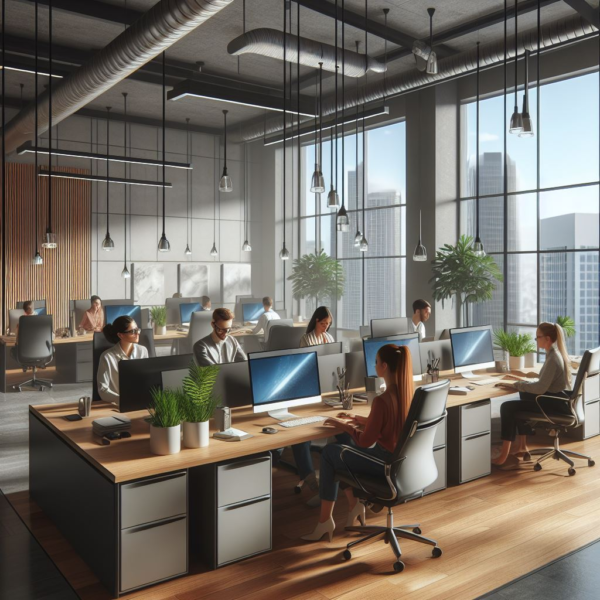The Power of Branding Interior Design Reflects Corporate Identity
In the world of business, branding isn’t just about logos and slogans; it’s a comprehensive reflection of a company’s values, mission, and identity. While branding often begins with marketing strategies and visual elements, it extends far beyond that, infiltrating every aspect of a company’s operations, including its physical spaces. Interior design plays a crucial role in this aspect, serving as a tangible manifestation of corporate branding and values. Let’s delve into how interior design shapes and reflects corporate identity, and the profound impact it has on customer perception.
1. Creating a Visual Identity:
First impressions matter, and the physical environment is often the first point of contact between a company and its customers. The interior design of a space sets the stage for the brand experience, conveying messages about the company’s personality, culture, and values. Whether it’s a sleek and modern office space or a cozy and rustic café, every design choice—from color schemes to furniture selection—sends subtle signals to visitors about what the brand stands for.
2. Reinforcing Brand Values:
Interior design has the power to reinforce brand values and ideologies. For instance, a company that prioritizes sustainability may incorporate eco-friendly materials and energy-efficient designs into its workspace. Similarly, a tech-savvy brand might opt for futuristic designs and cutting-edge technology to reflect innovation and progressiveness. By aligning the physical environment with brand values, companies can create a cohesive brand narrative that resonates with customers on a deeper level.

3. Enhancing Customer Experience:
The ambiance and layout of a space significantly impact customer experience and satisfaction. A well-designed interior can evoke specific emotions and attitudes, influencing how customers perceive the brand. For example, a welcoming and comfortable retail environment can encourage browsing and foster a sense of loyalty among shoppers. Likewise, a professional and organized office space can instill confidence in clients and partners, reinforcing the brand’s credibility and reliability.
4. Fostering Brand Recognition:
Consistency is key to effective branding, and interior design plays a crucial role in maintaining brand consistency across different touchpoints. By incorporating brand elements such as colors, logos, and design motifs into the physical space, companies can strengthen brand recognition and create a cohesive brand identity. This ensures that every interaction with the brand—whether online or offline—reinforces the same brand image and message.
5. Differentiating from Competitors:
In today’s competitive market landscape, standing out from the crowd is essential for success. Thoughtfully designed interior spaces can serve as a powerful differentiator, helping companies distinguish themselves from competitors and carve out a unique brand identity. Whether it’s through innovative design concepts, bold aesthetic choices, or immersive brand experiences, interior design can set a brand apart and leave a lasting impression on customers.
6.Setting the Tone with Color Schemes
Color psychology plays a significant role in influencing human emotions and behaviors. When designing a corporate office interior, choosing the right color scheme is essential in setting the desired tone and conveying the brand’s personality. For instance, a tech startup might opt for vibrant, energetic colors like orange or blue to reflect innovation and creativity, while a law firm might lean towards more subdued tones like gray or navy to convey professionalism and reliability. Incorporating the company’s brand colors into the interior design can further reinforce brand recognition and cohesion.
7. Branding Through Spatial Layouts
The spatial layout of a corporate office not only affects functionality but also serves as a powerful tool for branding. The arrangement of workspaces, meeting areas, and communal spaces can reflect the company’s values and priorities. For example, an organization that values collaboration and teamwork might opt for an open-plan layout with shared workstations and collaborative zones. Conversely, a company that prioritizes privacy and focus might prefer a more segmented layout with private offices and designated quiet areas. By aligning the spatial layout with the brand’s ethos, businesses can create a cohesive and authentic environment that resonates with employees and visitors alike.
8. Signage and Brand Messaging
Effective signage and brand messaging are crucial components of corporate interior design. From logo displays to inspirational quotes, these elements serve as visual cues that reinforce the company’s identity and values. Strategically placed signage can guide visitors through the space while subtly communicating key brand messages. Whether it’s a bold logo wall in the reception area or motivational slogans in the employee lounge, every piece of signage contributes to the overall brand experience. Additionally, incorporating digital displays or interactive screens can provide dynamic opportunities for showcasing brand content and engaging with stakeholders.
9. Furniture Selections and Brand Aesthetics
The choice of furniture plays a significant role in shaping the aesthetic and functionality of a interior corporate office. Beyond mere functionality, furniture selections can also convey the brand’s aesthetic preferences and values. For instance, sleek, modern furniture may align with a tech-savvy brand, while classic, timeless pieces may be more suitable for a heritage brand. Customized furniture pieces or branded fixtures can further reinforce brand identity and create a memorable impression on visitors. By carefully curating furniture selections that reflect the brand’s personality and ethos, companies can create cohesive and impactful interior spaces that resonate with their target audience.
In conclusion, interior design is much more than just aesthetics—it’s a strategic tool for expressing corporate identity, values, and culture. By carefully curating the physical environment to align with brand messaging, companies can create memorable brand experiences that resonate with customers and foster long-term loyalty. In today’s brand-driven world, the power of interior design in shaping customer perception and influencing purchasing decisions cannot be underestimated.


